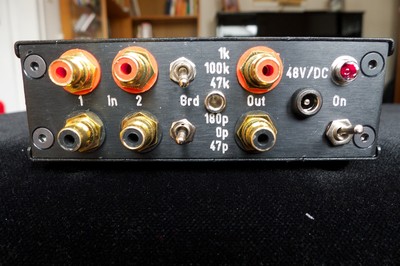Aikido Phono 2
Product type: Preamplifier/Processor Aikido Phono2
High - End preamplifier with passive equalizer network for MM and high level MC systems Input impedance and capacitance adjustable Amplifier with low noise field effect transistors
Technical data
Gain : 42 dB at 1kHz RIAA deviation : less than +/- 0,3 dB Frequency response : 20 Hz to 25 kHz -1dB 8 Hz to 50 kHz -3 dB Signal/Noise : better than - 88 dB A Distortion factor : less than 0.15 Input impedance : 100 Kohm, 47 kOhm, 1 Kohm switchable Input capacitance : 0 pF, 47 pF, 180 pF switchable Operating voltage : 48 V/DC 1 Watt
Description : This small AIKIDO phono preamplifier module inspires not only because of its technical data. Its advantages lie in the sonic area. The advantages of a "passive" equalization come to bear here in a remarkable form. To describe sounds is of course very difficult. Natural clarity, fascinating three-dimensionality, resonant highs and firm basses might be the right words. The amplifier can be optimally adapted to your MM system by the adjustable input resistance and the adjustable input capacitance! The principle of the Aikido amplifier is an established part of the Hi-FI high-end community in the USA and Japan. Especially in the tube amp scene this principle is highly praised. Simply times under AIKIDO or John Broskie Googlen. The amplifier works with field defect transistors. For the amplification 2 of the in the 70s very popular 2SK170 field effect transistors are used per channel. This transistor was popular in its time as very musical furthermore it is very low noise. The passive RIAA equalization is highly praised in high-end circles. Unfortunately, this type of RIAA equalization is used only in the rarest cases today. The reason for this may be the high demands that have to be made on the input amplifier stage. It has to process signals from 0.3 mV (20 Hz) to 30 mV (20kHz) cleanly. If you want to allow a certain amount of overdrive you will reach an input voltage of 100mV. If the first amplifier has a gain of e.g. 30 times, the output voltage after the first stage is 3 Volt RMS. That is round 9 V peak/peak........ Here it quickly becomes clear why this circuit concept is not so popular with developers. This is where the AIKIDO amplifier concept really comes into its own. The Aikido amplifier is characterized by high dynamic range and low distortion. A special feature is that the amplifier stage operates in Classe A mode. Furthermore, the AIKIDO amplifier does not require global negative feedback. Double mono construction up to separate adjustment of the input resistance and the input capacitance per channel! Connoisseurs among you can surely guess now why the RIAA amplifier offered here can probably compete with very high quality amplifiers.
Of course only selected good components are used: Wima capacitors Metal oxide resistors electrolytic capacitors from Panasonic etc.
No electrolytic capacitors in the signal path! Styroflex capacitors can be switched on at the input. High-quality 48 V/DC 6 Watt plug-in power supply from the brand manufacturer "Maen Well". 100 - 240 V/AC.
The amplifier board is enclosed in a sheet aluminium housing. This prevents interference with the electronics. The amplifier can be easily connected via the high quality sockets. Wooden housings for this module are available on request. The devices are manufactured by Dipl. Ing. H.-U. Otto in small series. Handwork "Made in Germany" therefore.
Remarks
Further models of the same series:
